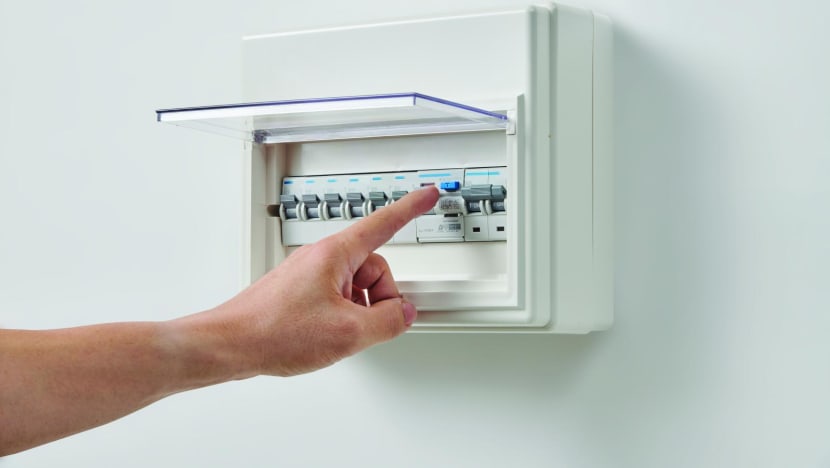Do you need to install a residual current circuit breaker? Here's what you need to know
With all homes required to install a residual current circuit breaker from July, here’s how to check if you already have one and whether it’s working.

Testing the RCCB switch. (Photo: Energy Market Authority)
SINGAPORE: From July, all homes in Singapore will be required to have a residual current circuit breaker (RCCB) installed, although home owners will be given a two-year grace period.
Since July 1985, all new homes are required to be installed with RCCBs. Those built before and after July 1985, that have undergone substantive renovations or electrical installation works, were also required to comply with this requirement.
But there is still a small percentage of homes built before July 1985 that may be using their original electrical circuits without the device installed.
According to data from Housing Board (HDB), about 1.3 per cent of one-room and two-room flats completed in and before 1985 are not installed with the device.
And about 2 per cent of three-room and larger flats completed in the same period either do not have it, or have an RCCB that does not protect the whole flat.
Not sure if you are one of these home owners? Here's what you need to know:
WHY DO I NEED AN RCCB?
The residual current circuit breaker located in your electrical distribution board is a safety device. It prevents electric shocks by cutting off the electricity supply when current leaks in your home are detected.
These leaks can be caused by ageing or exposed wires, faulty electrical appliances or damaged insulation.
HOW DO I KNOW IF I NEED TO INSTALL ONE?
Home owners living in HDB flats built before July 1985 will be notified by the Energy Market Authority (EMA) to install an RCCB in their homes if they have not already done so.
Those living in private homes, regardless of when they were built, will also be asked to check, and comply if they do not have one.

WHERE IS THE RCCB AND HOW TO KNOW IF IT'S WORKING?
Locate your electrical distribution board box at home.
Look for the switch with a test button. That is the RCCB.
EMA and HDB encourage all home owners to test the RCCB regularly to ensure that it is in good working condition.
And you can do that in just a few steps.
Before testing it, protect your appliances by switching them off.
Begin the test by pressing the test button. The RCCB switch will flip down, cutting off all power supply in the home.
Then test all the light switches and power sockets in every room. The lights and appliances will not turn on if the RCCB is working.
However, if any light or power socket continues to work, it means your house is not fully protected by the RCCB. You should contact a licensed electrical worker immediately.
To end the test, switch off all lights and power sockets. Then flip up the RCCB switch to restore power supply.
If you are an HDB home owner and you can't find your RCCB, you may contact your HDB branch service line at 1800-225-5432 or www.hdb.gov.sg/efeedback for help.
Those living in private homes can contact a licensed electrical worker or visit go.gov.sg/rccb-lew for assistance.

HOW MUCH DOES IT COST?
- one-room and two-room HDB flats
The cost of the installation and necessary rewiring works for one-room and two-room flats will be fully funded by the government. To provide support to lower-income households, HDB has already been carrying out installation works for one-room and two-room HDB flats completed in and before 1985.

- three-room and larger HDB flats
For owners of three-room and larger flats completed in and before 1985 and which do not have an RCCB installed, HDB will be writing to them to share about the RCCB installation assistance programme.
Under the programme, the government will subsidise up to 95 per cent of the cost of the installation and necessary rewiring works.
- Private home owners
EMA will also notify all private home owners to check if they have a working RCCB in their homes. If not, they can engage a licensed electrical worker to get it done.
The costs will be borne by the private home owner.
WHAT IS THE PENALTY?
All home owners will be given a two-year grace period to install the RCCB.
After the grace period, EMA or its appointed agents will conduct random enforcement checks, focusing on pre-1985 HDB flats and private homes.
Any home found without a RCCB installed will be issued with a written warning and given another eight weeks to install the device.
The penalty for non-compliance is a fine of up to S$5,000.
However, home owners with a faulty RCCB will not be penalised.
If they suspect that their residual current circuit breaker is faulty, they should engage a licensed electrical worker to conduct further checks, and have it replaced, said the authorities.
All home owners can engage a licensed electrical worker at go.gov.sg/rccb-lew for installation works.















